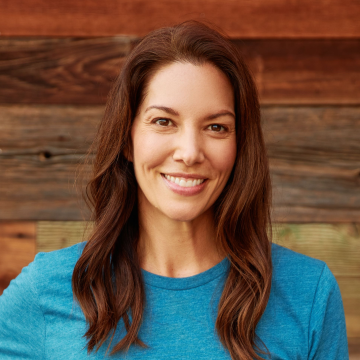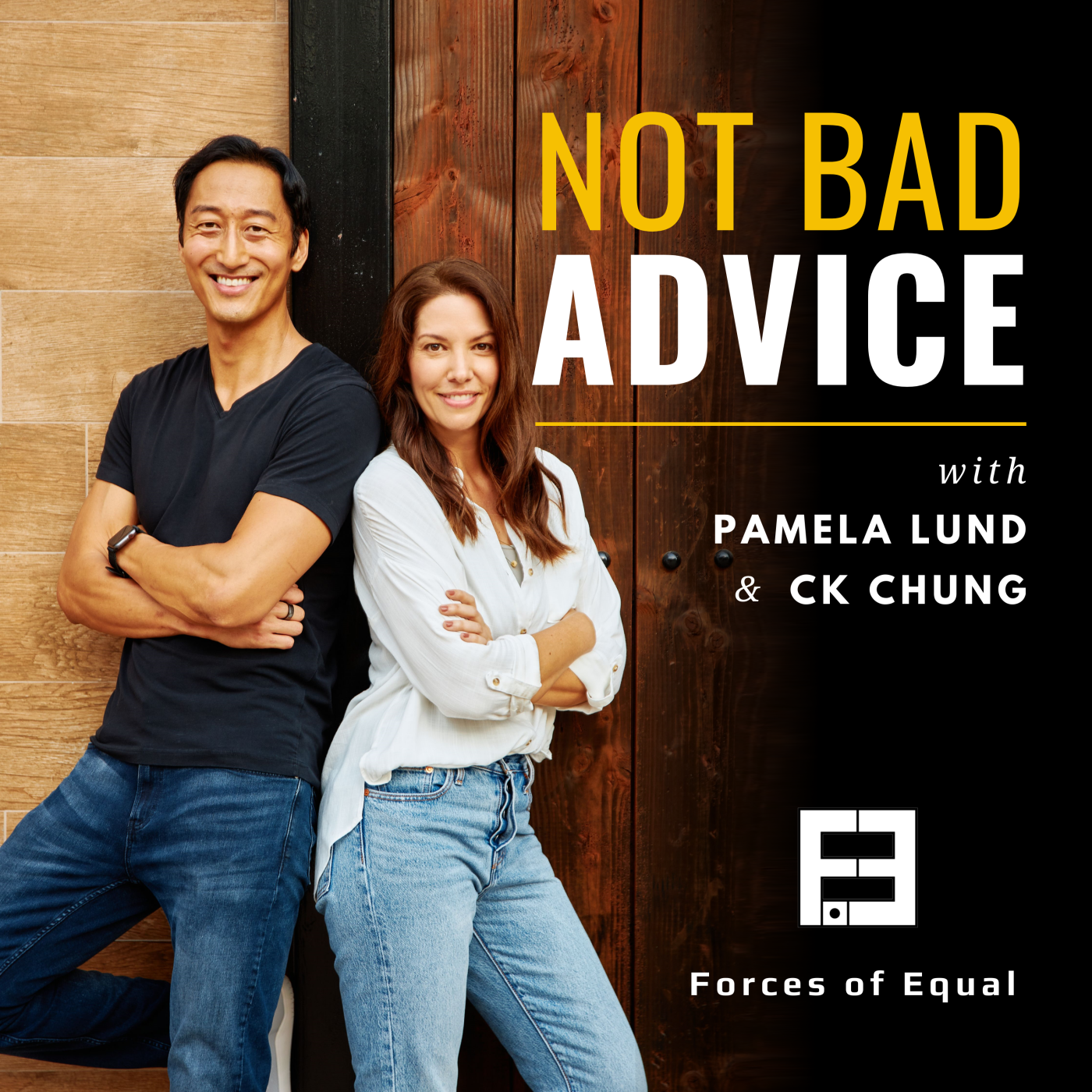What you think directly impacts how you behave, and how you behave directly impacts what you get out of life. And that, in turn, influences how you think and the whole cycle starts again.
Need advice about something? Ask us here: ForcesOfEqual.com/Advice/
Transcript
Pam: [00:06] You’re listening to Not Bad Advice where our goal is to offer perspective that helps you improve one aspect of your life at a time.
[00:13] I’m Pamela Lund.
CK: [00:20] And I’m CK Chung.
Pam: [00:22] And we hope that after listening you’ll think, “Hey, that’s not bad advice!”
[00:26] There’s a lot of woo-woo stuff that many people – me included – roll their eyes at, but that is actually rooted in science. One of those things is that you can use your thoughts to change reality.
CK: [00:51] Like… manifesting.
Pam: [00:53] You could call it that, but as soon as you say the word “manifesting,” a lot of people tune out. Manifesting conjures up images of The Secret or candlelight rituals, crystals, and summoning spirit guides. And if you’re into that, great. Do it. But I want to talk about how simple shifts in how you think about what you want can increase the likelihood that you’ll get it.
[01:20] What you think directly impacts how you behave, and how you behave directly impacts what you get out of life. And that, in turn, influences how you think and the whole cycle starts again.
CK: [01:32] You can see extreme examples of this in people who have extremist views. Let’s take doomsday preppers, for example. They honestly think the world is going to end or the apocalypse is coming, and they need to be prepared for it. The fact that other people don’t think the way they do just fuels their conviction and makes them double down on it.
[01:54] That’s their reality. And you can’t tell them any different. They’ve created their own world, where they require a bunker with weapons and months worth of canned food, purely by thinking it into reality. It doesn’t matter if others don’t agree with their reality because they’ve become psychologically rigid within the limitation of their own beliefs.
Pam: [02:14] Exactly. And because they’ve created that reality, they do things that support it. Doing things that support their reality reinforces that it is real and that reinforces their beliefs about it. But you don’t have to be a prepper to create a new reality with your thoughts.
[02:33] In Atomic Habits, James Clear writes that in order to achieve a goal, you have to become the person that does the thing you want to do. You have to make it part of your identity. Because if what you’re trying to do, doesn’t match who you think you are, you’ll sort of sabotage yourself because you won’t think you can or should get what you want.
[02:53] You have to align your identity with what you want to achieve. Not wait to achieve it and think it will make you someone else.
[03:02] I have a very simple example of this from my own life. I tried to get air quotes in shape every few months for most of my adult life. And I never made it very far because I was always focused on becoming some idealized future version of myself that was disconnected from who I was in the present. I’d workout for a week or even a few months, but I always gave up because I was working out for a version of me that I didn’t really believe could exist.
[03:34] A few years ago, I decided to stop trying to change future me, and to change current me instead. So I made working out part of my identity. I became someone who worked out three times a week. It was part of my schedule. My friends knew my routine. My clients knew I wasn’t available during certain hours because that’s when I worked out. I made being someone who works out regularly, part of who I was.
[04:01] By focusing on being someone who works out, I achieved my goal of getting in shape and have maintained it because being fit is part of my identity now. I changed who I thought I was in the present, and that created a new reality for the future.
CK: [04:20] We talked about examples of this in the money episodes that we published recently, too. Like, if you think you don’t deserve to be paid more, you won’t ask for more, and that’ll reinforce your perception that you’re getting as much as you deserve. But if you think that you are worth more, you’ll behave like someone who is with more. You’ll do good work and you’ll ask for more money or find a better paying job.
[04:45] Or if you think you’re bad with money, you won’t take the steps to manage it well. Then, when you have financial problems, your belief that you are bad with money will be reinforced. But if you make being good with money and part of your identity and believe that you are capable of making good financial decisions, you will.
Pam: [05:04] Yeah, you will, it might not happen overnight, but it will happen. And competence creates confidence. So the more you do things that you need to do to be the person you’ve decided you are the easier it will be, and the more you’ll get opportunities that align with what you’re trying to achieve.
CK: [05:23] In David Sedaris’ masterclass, he talks about this as it relates to writing. He says that you have to identify as a writer and you have to write every day. If you’re focused on the goal of writing a book, but you’re not writing daily, you’re not being the person that’ll write a book. You have to think and act like you’re a writer.
[05:46] Then over time, you’ll find your voice and become more confident in your writing, which will reinforce the feeling that you really are a writer. As you become more confident in your writing, you’ll share it or submit it for publication or go to readings. And all of those actions will tell the world that you are a writer.
[06:03] And in return, you’ll receive opportunities that writers receive, such as a book deal. If you don’t think that you can publish your writing and therefore haven’t practiced writing every day, you’re probably not going to get a book deal.
Pam: [06:15] Right. You have to believe you can do what you want, and then behave in the way that will get it. All starts with how you think and what energy you’re putting out there. That energy gets returned in the form of opportunities, introductions, and other things that can feel random or like they happen by chance. But they don’t. They happen because you are thinking and acting in ways that invite it into your life.
[06:43] At the end of this episode, we’re going to do a visualization technique to help you use your intuition to identify three things you need to focus on to become the person who will achieve the things you want. So right now, I want you to think of something you want to achieve. It can be anything as long as it’s something specific that you can visualize.
CK: [07:04] Okay. I’m visualizing my numbers coming up in the lottery.
Pam: [07:09] Okay, well then something you can visualize that you can take actions to achieve. I mean, I guess you could buy a ton of lottery tickets, but you’ll probably run out of money before you win. So think of something that you want to achieve, that you need to actively participate in, and that isn’t left purely up to chance.
[07:30] But that doesn’t mean you need to be realistic. In fact, I encourage you to be unrealistic. If you’re going to manifest something, it might as well be the best thing you can think of, right?
[07:41] Also, and this is important. Don’t worry about how you’ll get what you’re thinking about. How doesn’t really matter that much. There are a million ways to get where you want to go. And if you get too focused on how, you’ll get stuck on logistics, and either won’t get there at all, or you’ll miss a better path.
[08:02] Once you have your totally unrealistic goal, start thinking about who you need to be to achieve it. Not how you will achieve it, but who you need to be to achieve it. Focus your thoughts on being that person and align your day-to-day actions with your new thoughts. When you do, you’ll start seeing synchronicities everywhere. Opportunities will show up that seem uncanny. You’ll meet people that can help you along the way, or you’ll learn things that propel you in the right direction.
[08:37] Finally, keep in mind that no matter what you think you want to achieve, it’s probably not actually what will make you happy. But on the way towards achieving what you think you want, you will find what does actually make you happy. So go big and stay open to how things change. Eventually you’ll look back and see that it almost seems like the universe conspired to get you exactly where you are.
[09:03] Instead of a card today, we’re going to do a quick visualization technique to help you find the behaviors you need to focus on to achieve your goal . You can use this technique. Anytime you want to connect with what you’re trying to achieve, or as part of your morning routine to set intentions for the day.
[09:44] We’ll use a contrasting technique to visualize what you don’t want first, and then what you do. This will solidify what you’re trying to move away from and what you want to move towards.
[09:56] So if you can, find a comfortable place to sit for the next few minutes. You’re going to need to close your eyes, so please don’t do this while you’re driving.
[10:09] Get comfortable and close your eyes. Think about the goal you’re trying to achieve. Next, you’re going to take a deep breath and I’m going to say the number three, three times as you exhale. As I do, picture the number three in your head, any way that you want. When I do this, I always picture them being written because the movement calms me, but you can do whatever you like.
[10:33] Then, we’re going to repeat that process with two more breaths, as I say the number two and the number one, three times each.
[10:40] So, deep breath in. Exhale. Three, three, three. Two, two, two. One, one, one. Relax your neck and shoulders. Breathe normally, and scan your body for any tension that you can release. Relax your face, your arms, your legs. Sink into your body.
[11:40] Now in your head, picture a movie screen on a wall. On the screen, see a projection of what you don’t want. Maybe this is the opposite of your goal. Maybe it’s what you’ve got right now. Maybe you’re stressed out at your computer, or fighting with a spouse, or working at a job you hate. Whatever it is, see yourself living the life you don’t want to live as though it’s a movie playing on the screen.
[12:15] Hear the sounds that go with the scene. See yourself interacting with objects around you, and feel the emotions that come with being in that situation. Really connect with how what you don’t want feels when you’re living in it.
[12:40] Now destroy that screen. See it go up in flames, or rip into shreds, or whatever feels good to you. And then wipe away what’s left to reveal a new blank screen.
[12:54] Now on the screen, see a projection of what you do want. Go through the same process of noticing details. Really see yourself in that situation, and feel what it would feel like to be there.
[13:17] How does that version of you think? How do they act? What do they do differently than you do now? How does that version of you see themselves?
[13:34] Next, you’re going to take three deep, slow breaths. And on each exhale, I want you to think of one thing you can do differently to be that version of you that you just saw on the screen. Maybe you’ll hear that you need to find a mentor or ask for help. Maybe you’ll hear that you need to learn a new skill or be kinder to yourself.
[14:04] There are no wrong answers. Just ideas.
[14:09] Here we go.
[14:10] Breathe in… and out. In… and out. In… and out.
[14:38] Now take an even deeper breath. Hold it for a few seconds… and smile as you exhale.
[14:49] Now, open your eyes.
[14:55] Write down the three things you need to do to become the person that you saw on the screen. I know from experience that things that come up during these types of mini meditations can disappear like dreams do. They’ll seem really obvious and easy to remember right now, but in an hour, they’ll be gone.
[15:14] Use that list of three things to guide what thoughts you need to have and what actions you need to make a part of your identity. So you can achieve your goal or something even better.
[15:23] If you found yourself thinking, “Hey, that’s not bad advice,” while listening today, we’d love it if you shared the episode with your friends and rated it in iTunes.
[15:35] You can get in touch with us on Twitter, where I’m @Pamela_Lund and CK is @cKdisco.
[15:42] To find us on other platforms, visit ForcesOfEqual.com/Advice. There, you can also contact us if there’s something you need advice about. We’d love to hear from you.






